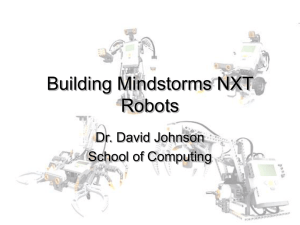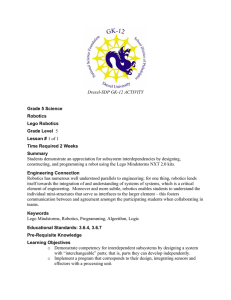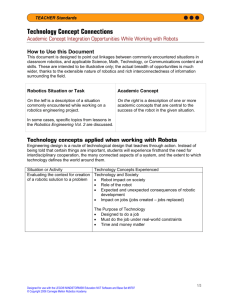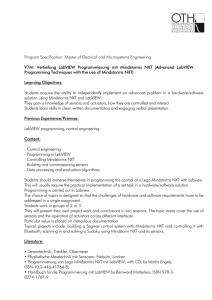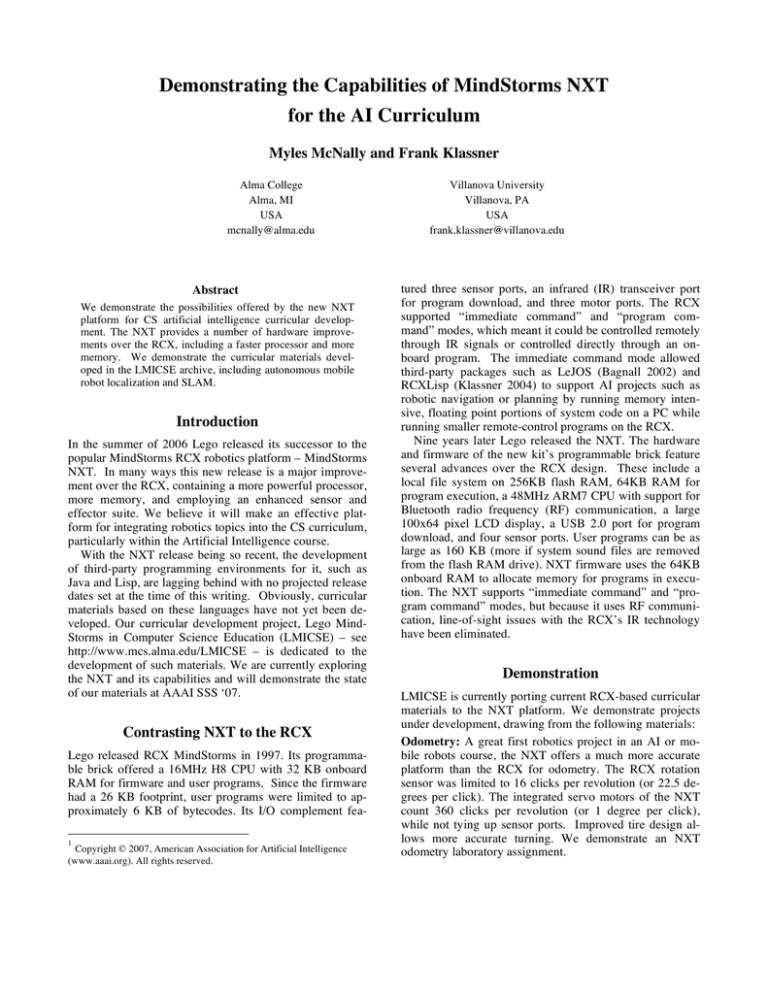
Demonstrating the Capabilities of MindStorms NXT
for the AI Curriculum
Myles McNally and Frank Klassner
Alma College
Alma, MI
USA
mcnally@alma.edu
Abstract 1
We demonstrate the possibilities offered by the new NXT
platform for CS artificial intelligence curricular development. The NXT provides a number of hardware improvements over the RCX, including a faster processor and more
memory. We demonstrate the curricular materials developed in the LMICSE archive, including autonomous mobile
robot localization and SLAM.
Introduction
In the summer of 2006 Lego released its successor to the
popular MindStorms RCX robotics platform – MindStorms
NXT. In many ways this new release is a major improvement over the RCX, containing a more powerful processor,
more memory, and employing an enhanced sensor and
effector suite. We believe it will make an effective platform for integrating robotics topics into the CS curriculum,
particularly within the Artificial Intelligence course.
With the NXT release being so recent, the development
of third-party programming environments for it, such as
Java and Lisp, are lagging behind with no projected release
dates set at the time of this writing. Obviously, curricular
materials based on these languages have not yet been developed. Our curricular development project, Lego MindStorms in Computer Science Education (LMICSE) – see
http://www.mcs.alma.edu/LMICSE – is dedicated to the
development of such materials. We are currently exploring
the NXT and its capabilities and will demonstrate the state
of our materials at AAAI SSS ‘07.
Contrasting NXT to the RCX
Lego released RCX MindStorms in 1997. Its programmable brick offered a 16MHz H8 CPU with 32 KB onboard
RAM for firmware and user programs. Since the firmware
had a 26 KB footprint, user programs were limited to approximately 6 KB of bytecodes. Its I/O complement fea1
Copyright © 2007, American Association for Artificial Intelligence
(www.aaai.org). All rights reserved.
Villanova University
Villanova, PA
USA
frank.klassner@villanova.edu
tured three sensor ports, an infrared (IR) transceiver port
for program download, and three motor ports. The RCX
supported “immediate command” and “program command” modes, which meant it could be controlled remotely
through IR signals or controlled directly through an onboard program. The immediate command mode allowed
third-party packages such as LeJOS (Bagnall 2002) and
RCXLisp (Klassner 2004) to support AI projects such as
robotic navigation or planning by running memory intensive, floating point portions of system code on a PC while
running smaller remote-control programs on the RCX.
Nine years later Lego released the NXT. The hardware
and firmware of the new kit’s programmable brick feature
several advances over the RCX design. These include a
local file system on 256KB flash RAM, 64KB RAM for
program execution, a 48MHz ARM7 CPU with support for
Bluetooth radio frequency (RF) communication, a large
100x64 pixel LCD display, a USB 2.0 port for program
download, and four sensor ports. User programs can be as
large as 160 KB (more if system sound files are removed
from the flash RAM drive). NXT firmware uses the 64KB
onboard RAM to allocate memory for programs in execution. The NXT supports “immediate command” and “program command” modes, but because it uses RF communication, line-of-sight issues with the RCX’s IR technology
have been eliminated.
Demonstration
LMICSE is currently porting current RCX-based curricular
materials to the NXT platform. We demonstrate projects
under development, drawing from the following materials:
Odometry: A great first robotics project in an AI or mobile robots course, the NXT offers a much more accurate
platform than the RCX for odometry. The RCX rotation
sensor was limited to 16 clicks per revolution (or 22.5 degrees per click). The integrated servo motors of the NXT
count 360 clicks per revolution (or 1 degree per click),
while not tying up sensor ports. Improved tire design allows more accurate turning. We demonstrate an NXT
odometry laboratory assignment.
Figure 1: RCX with Sonar and Rotation
Sensors
Path Planning: Well developed for the RCX (McNally
2006), occupancy-grid based solutions to the path planning
problem can be employed in the CS curriculum as early as
CS 2 (given a provided odometry solution). Experience
with classical path search algorithms such as depth and
breadth-first search on the RCX was described in (Kumar
2004). Our RCX materials incorporate options to use such
methods or to use wave-front propagation, either with a
known environment map or without one. With the increased memory of the NXT and the more accurate odometry, much larger occupancy-grids will be possible
Localization: Monte Carlo methods are well suited for the
fast and accurate localization of autonomous mobile robots. Our robust RCX materials employ the particle filtering approach described by (Fox 2003), whose linear example was implemented by (Greenwald et al 2006). Due to
memory constraints it was not possible to do localization
on-board the RCX, but this is not a problem for the NXT.
We demonstrate MCL on the NXT.
Mapping: 1-d and 2-d mapping projects are under development for use in this sequence of laboratory materials.
We will demonstrate the current status of these materials,
which should include one and two-dimensional solutions to
the mapping problem.
SLAM: The end point of this sequence of laboratory materials, these materials are under development as well. Not
developed for the RCX, this approach should be possible
for NXT. We demonstrate the current state of the art for
NXT.
Conclusion
Lego MindStorms NXT provides enhanced opportunities
for incorporating appropriate robotics projects in the undergraduate AI course or for a course in autonomous mobile robotics. LMICSE is a repository for MindStormsbased CS curricular material, and in this paper we have
Figure 2: NXT with Sonar Sensor
described the possibilities provided by the new MindStorms NXT platform and the materials being developed
for LMICSE for NXT.
Acknowledgements
This work was partially supported by a National Science
Foundation CISE Educational Grant (EIA-0306096).
References
Bagnall, B. 2002. Core LEGO MINDSTORMS Programming: Unleash the Power of the Java Platform. Upper
Saddle River, NJ: Prentice Hall
Fox, D. 2003. Adapting the Sample Size in Particle Filters
Through KLD-Sampling. International Journal of Robotics
Research 22(12):985-1003.
Greenwald, L., Artz, D., Mehta, Y., and Shirmohammadi,
B. 2006. Using Educational Robotics to Motivate Complete AI Solutions. AI Magazine 27(1):83-95.
Klassner, F. 2004. Enhancing Lisp Instruction with
RCXLisp and Robotics. In Proceedings of 35th SIGCSE
Technical Symposium on Computer Science Education
(SIGCSE 2004), 214-218. Norfolk, VA: ACM Press.
Kumar, A. 2004. Three years of using robots in an artificial
intelligence course: lessons learned. Journal on Educational Resources in Computing (JERIC) 4(3).
McNally, M. 2006. Walking the Grid: Robotics in CS 2. In
Proceeding of the Eighth Australasian Computing Education Conference, 151-155. Hobart, Australia: Australian
Computer Society Inc.



